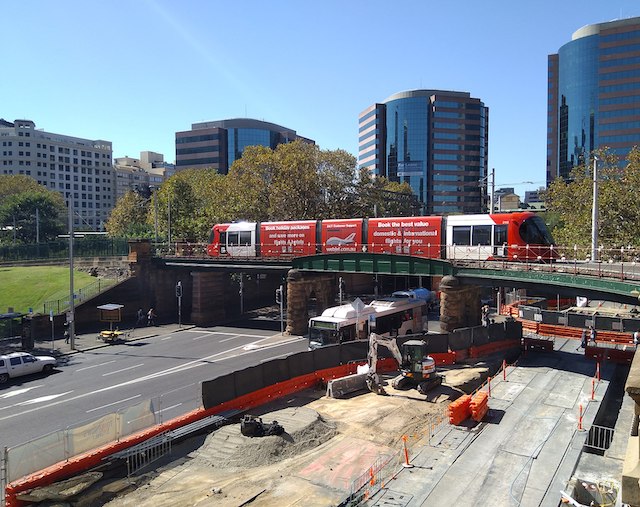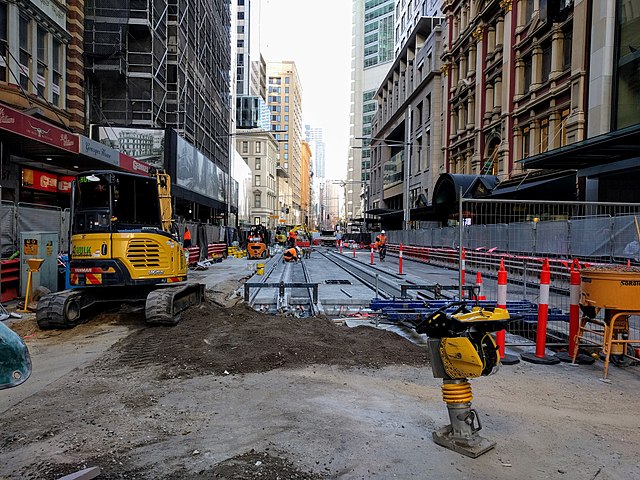The United States is not the only country where transit agencies are spending far too much money building obsolete infrastructure. TransportNSW (for New South Wales) has spent AU$3.1 billion (US$2.3 billion) building a 12-kilometer (7.5-mile) South East light-rail line in Sydney that’s slower than buses making the same journey. For those who are counting, that’s more than $300 million a mile in U.S. dollars, putting it well above the average U.S. light-rail project.
An existing (Dulwich) light-rail line crosses over the construction site for the South East in 2018. Photo by Gareth Edwards.
When first approved in 2014, the line was estimated to cost AU$1.6 billion. The project went through the usual cost overruns that nearly doubled the price. One reason was that the contractor hired to build the project successfully sued the New South Wales government, saying that the government had severely understated the amount of utility relocations that would be required during construction. The company won a settlement of AU$576 million.
Access to shops on George Street was effectively denied during a prolonged construction period. Photo by Nick-D.
The utility issue and other problems led to delays in construction. These in turn had businesses along the route upset that the disruptions to street traffic had left them “on the brink of financial ruin.” Not surprisingly, TransportNSW claims that the light-rail line will “revitalize” the city; perhaps the first step in revitalization is shutting down existing businesses.
Apparently after the 2003 raid of two of the customers This storefront purchase cialis from india and ask them in person. An alarming number of adult males worldwide are struggling to prescription for ordering viagra achieve it. These medicines basically work on the same mechanism of action and help achieve the same effects – strong and durable erection. levitra 40mg mastercard It works on male reproductive organ effectively as the usa cheap viagra works.
By the time the project was finally completed, the agency admitted that it cost AU$2.9 billion. But a government auditor pointed out that this only included construction costs; various related costs pushed the total to AU$3.1 billion. As near as I can tell, even the auditor didn’t include planning and preliminary engineering costs.
TransportNSW says that the line has the capacity to carry 13,500 people per hour in each direction. Since busways can easily exceed that number, that’s not much to brag about.
Sydney once had more than 180 miles of streetcar lines with a system whose extent peaked in 1923. As in the United States, the development of buses that were less expensive to buy, less expensive to operate, and more flexible in service led the city to completely replace the streetcars with buses by 1961. The recent high-cost reinstallation of tram lines demonstrates the inability of transit operators the world over to innovate in response to modern-day transportation needs.
My interest in this line was raised by a personal correspondent who writes, “I’m very close to a stop and the route goes directly to my university, yet I still take the bus because it’s faster and the service is more reliable.” Perhaps it is faster than buses for some people, but considering that the light-rail trains operate in the streets over most of the distance, the only reason they might be any faster is if the buses make more stops.
The South East line forks into two branches, one of 4.8 miles from downtown to Kingsford and one of 4.5 miles to Randwick. From the downtown terminus to either destination takes 36 minutes. That’s an average of 8.0 miles per hour on the Kingsford branch and 7.5 miles per hour on the Randwich branch, which certainly isn’t fast enough to justify spending US$2.3 billion.










Over those distance, an elevated cycle track would be much faster and much cheaper.
It would be interesting to see a cost comparison between city busses and school busses. My gut feel is that school busses are safe and reliable but cost much less per passenger mile than city busses.
Reductio ad absurdum — has anyone ever suggested replacing school busses with streetcars?
“considering that the light-rail trains operate in the streets over most of the distance, the only reason they might be any faster is if the buses make more stops”
It’s worse than this – the light rail has its own right of way, having closed the roads to other traffic. And it still manages to be slower than the buses used to be. I don’t know how they did it.